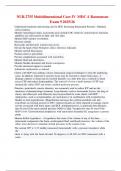Exam (elaborations)
NUR 2755 Multidimensional Care IV MDC 4 Rasmussen Exam 9 2025/26
- Course
- Institution
NUR 2755 Multidimensional Care IV MDC 4 Rasmussen Exam 9 2025/26 NUR 2755 Multidimensional Care IV MDC 4 Rasmussen Exam 9 2025/26 NUR 2755 Multidimensional Care IV MDC 4 Rasmussen Exam 9 2025/26 NUR 2755 Multidimensional Care IV MDC 4 Rasmussen Exam 9 2025/26 NUR 2755 Multidimensional Care ...
[Show more]



